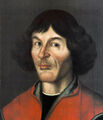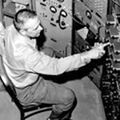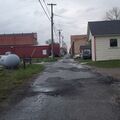Template:Selected anniversaries/May 24: Difference between revisions
No edit summary |
No edit summary |
||
| (11 intermediate revisions by the same user not shown) | |||
| Line 1: | Line 1: | ||
<gallery> | <gallery> | ||
|| *** DONE: Pics *** | |||
File:Lanfranc circa 1100.jpg|link=Lanfranc (nonfiction)|1089: Celebrated jurist and monk [[Lanfranc (nonfiction)|Lanfranc]] dies. | File:Lanfranc circa 1100.jpg|link=Lanfranc (nonfiction)|1089: Celebrated jurist and monk [[Lanfranc (nonfiction)|Lanfranc]] dies. | ||
File:Nikolaus Kopernikus.jpg|link=Nicolaus Copernicus (nonfiction)|1543: Mathematician and astronomer [[Nicolaus Copernicus (nonfiction)|Nicolaus Copernicus]] dies. He formulated a model of the universe that places the Sun rather than the Earth at the center of the universe. | File:Nikolaus Kopernikus.jpg|link=Nicolaus Copernicus (nonfiction)|1543: Mathematician and astronomer [[Nicolaus Copernicus (nonfiction)|Nicolaus Copernicus]] dies. He formulated a model of the universe that places the Sun rather than the Earth at the center of the universe. | ||
||1544: | ||1544: Physician, physicist and natural philosopher William Gilbert born. He passionately rejected both the prevailing Aristotelian philosophy and the Scholastic method of university teaching. He is remembered today largely for his book ''De Magnete'' (1600), and is credited as one of the originators of the term "electricity". Pic. | ||
File:Daniel Gabriel Fahrenheit.jpg|link=Daniel Gabriel Fahrenheit (nonfiction)|1686: Physicist and engineer [[Daniel Gabriel Fahrenheit (nonfiction)|Daniel Gabriel Fahrenheit]] born. He will help lay the foundations for the era of precision thermometry by inventing the mercury-in-glass thermometer and the Fahrenheit scale. | File:Daniel Gabriel Fahrenheit.jpg|link=Daniel Gabriel Fahrenheit (nonfiction)|1686: Physicist and engineer [[Daniel Gabriel Fahrenheit (nonfiction)|Daniel Gabriel Fahrenheit]] born. He will help lay the foundations for the era of precision thermometry by inventing the mercury-in-glass thermometer and the Fahrenheit scale. | ||
| Line 20: | Line 22: | ||
File:Telegraph.jpg|link=Electrical telegraph (nonfiction) |1844: [[Samuel Morse (nonfiction)|Samuel Morse]] sends the message "What hath God wrought" (a biblical quotation, Numbers 23:23) from the Old Supreme Court Chamber in the United States Capitol to his assistant, Alfred Vail, in Baltimore, Maryland, to inaugurate a commercial [[Electrical telegraph (nonfiction) |telegraph line]] between Baltimore and Washington D.C. | File:Telegraph.jpg|link=Electrical telegraph (nonfiction) |1844: [[Samuel Morse (nonfiction)|Samuel Morse]] sends the message "What hath God wrought" (a biblical quotation, Numbers 23:23) from the Old Supreme Court Chamber in the United States Capitol to his assistant, Alfred Vail, in Baltimore, Maryland, to inaugurate a commercial [[Electrical telegraph (nonfiction) |telegraph line]] between Baltimore and Washington D.C. | ||
||1868: Charlie Taylor born ... engineer and mechanic. | ||1868: Charlie Taylor born ... engineer and mechanic, aircraft engines. Pic. | ||
||1906: Harry Hammond Hess born ... geologist who made the first comprehensive attempt at explaining the phenomenon of seafloor spreading (1960). This revived Alfred Wegener's earlier theory of continental drift. Together, these provided an interpretation of the earth's crust in terms of plate tectonics. The surface of the globe is not continuous. Rather, it is broken into a number of huge plates that float on the molten rock under the crust, moved over eons of geologic time by convective currents driven by earth's internal heat. With this motion these plates rub against, collide with, or separate from other plates. Thus the nature of earthquakes and volcanoes could be explained, plus the existence of ridges of young rock mapped around the globe under the ocean where the sea floor was spreading. Pic. | ||1906: Harry Hammond Hess born ... geologist who made the first comprehensive attempt at explaining the phenomenon of seafloor spreading (1960). This revived Alfred Wegener's earlier theory of continental drift. Together, these provided an interpretation of the earth's crust in terms of plate tectonics. The surface of the globe is not continuous. Rather, it is broken into a number of huge plates that float on the molten rock under the crust, moved over eons of geologic time by convective currents driven by earth's internal heat. With this motion these plates rub against, collide with, or separate from other plates. Thus the nature of earthquakes and volcanoes could be explained, plus the existence of ridges of young rock mapped around the globe under the ocean where the sea floor was spreading. Pic. | ||
| Line 29: | Line 31: | ||
File:Igor Sikorsky 1914.jpg|link=Igor Sikorsky (nonfiction)|1940: [[Igor Sikorsky (nonfiction)|Igor Sikorsky]] performs the first successful single-rotor helicopter flight. | File:Igor Sikorsky 1914.jpg|link=Igor Sikorsky (nonfiction)|1940: [[Igor Sikorsky (nonfiction)|Igor Sikorsky]] performs the first successful single-rotor helicopter flight. | ||
||1962: Project Mercury: American astronaut Scott Carpenter orbits the Earth three times in the Aurora 7 space capsule. | ||1962: Project Mercury: American astronaut Scott Carpenter orbits the Earth three times in the Aurora 7 space capsule. | ||
||1965: Lucien Lévy dies ... radio engineer and radio receiver manufacturer. He invented the superheterodyne method of amplifying radio signals, used in almost all AM radio receivers. His patent claim was at first disallowed in the United States in favour of the American Edwin Howard Armstrong, but on appeal Lévy's claim as inventor was accepted in the US. Pic. | ||1965: Lucien Lévy dies ... radio engineer and radio receiver manufacturer. He invented the superheterodyne method of amplifying radio signals, used in almost all AM radio receivers. His patent claim was at first disallowed in the United States in favour of the American Edwin Howard Armstrong, but on appeal Lévy's claim as inventor was accepted in the US. Pic. | ||
||Clyde | File:Clyde Cowan.jpg|link=Clyde Cowan (nonfiction)|1974: Physicist [[Clyde Cowan (nonfiction)|Clyde Cowan]] dies. Cowan, along with Frederick Reines, discovered the neutrino in 1956; Reines received the Nobel Prize in Physics in 1995 in both their names. | ||
||1977: Alfred Schild dies ... physicist, well known for his contributions to the Golden age of general relativity (1960–1975). Pic: https://ru.wikipedia.org/wiki/%D0%A8%D0%B8%D0%BB%D1%8C%D0%B4,_%D0%90%D0%BB%D1%8C%D1%84%D1%80%D0%B5%D0%B4 | ||1977: Alfred Schild dies ... physicist, well known for his contributions to the Golden age of general relativity (1960–1975). Pic: https://ru.wikipedia.org/wiki/%D0%A8%D0%B8%D0%BB%D1%8C%D0%B4,_%D0%90%D0%BB%D1%8C%D1%84%D1%80%D0%B5%D0%B4 | ||
||2019: Murray Gell-Mann dies ... physicist who received the 1969 Nobel Prize in Physics for his work on the theory of elementary particles. Pic. | |||
File:Alley (24 May 2024) 20240524_203349.jpg|link=Alley (24 May 2024)|2024: '''[[Alley (24 May 2024)]]'''. | |||
</gallery> | </gallery> | ||
{{Template:Categories: May 24}} | |||
Latest revision as of 19:40, 29 May 2024
1089: Celebrated jurist and monk Lanfranc dies.
1543: Mathematician and astronomer Nicolaus Copernicus dies. He formulated a model of the universe that places the Sun rather than the Earth at the center of the universe.
1686: Physicist and engineer Daniel Gabriel Fahrenheit born. He will help lay the foundations for the era of precision thermometry by inventing the mercury-in-glass thermometer and the Fahrenheit scale.
1734: Chemist and physician Georg Ernst Stahl dies. His works on phlogiston continue to be accepted as an explanation for chemical processes until the late 18th century.
1844: Samuel Morse sends the message "What hath God wrought" (a biblical quotation, Numbers 23:23) from the Old Supreme Court Chamber in the United States Capitol to his assistant, Alfred Vail, in Baltimore, Maryland, to inaugurate a commercial telegraph line between Baltimore and Washington D.C.
1928: Mathematician Bertram Kostant born. He will be one of the principal developers of the theory of geometric quantization.
1940: Igor Sikorsky performs the first successful single-rotor helicopter flight.
1974: Physicist Clyde Cowan dies. Cowan, along with Frederick Reines, discovered the neutrino in 1956; Reines received the Nobel Prize in Physics in 1995 in both their names.
2024: Alley (24 May 2024).







